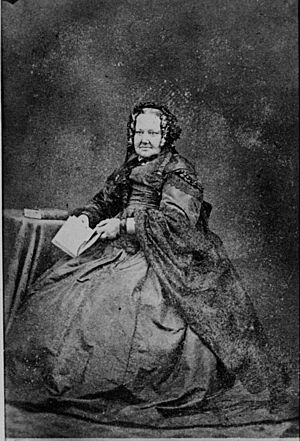Anne Camfield facts for kids
Quick facts for kids
Anne Camfield
|
|
|---|---|

Camfield in the 1860s
|
|
| Born | c. 1808 Staffordshire, England
|
| Died | 18 February 1896 |
| Nationality | British |
| Occupation | Governess/teacher |
| Known for | Founding Camfield House school |
| Spouse(s) | Henry Camfield |
Anne Camfield (born Anne Breeze; around 1808 – 18 February 1896) was a pioneering teacher and headmistress in Western Australia. She also took photographs. Anne is famous for starting the first school for Aboriginal children in Western Australia, which was called Annesfield.
Contents
Her Early Life and Journey
Anne Camfield was born around 1808 in Staffordshire, England. Her father was said to have made pottery. Back then, it was rare for women to be missionaries, but Anne was accepted as a governess. A governess was a private teacher who lived with a family. She traveled to Australia with Reverend William Mitchell and his family. Their journey was supported by a church society.
They arrived in the Swan River Colony (which is now Western Australia) on August 4, 1838. Reverend Mitchell started a mission school for both settler children and Aboriginal children. Anne Breeze helped him teach at this school.
Marriage and New Beginnings
On December 19, 1840, Anne married Henry Camfield. He had been in Australia since 1829 and owned a piece of land called Burrswood.
In 1847, Henry became the Resident Magistrate in Albany. This was an important job, like being a local judge and leader. Albany was a small town at the time, with about 250 European residents.
The next year, Albany opened its first church. John Ramsden Wollaston became the chaplain, who was a friend of the Camfields. Later, Matthew Hale, who would become a bishop, became good friends with Anne. They wrote letters to each other for many years.
Founding Annesfield School

In 1852, the Camfields built their home, which was also known as Annesfield. This house would become very important for education. John Wollaston, like Anne, cared deeply about young Aboriginal children. He wrote to the government, explaining that the Camfields' new house had extra space. Anne was willing to take six children into her home to teach them.
Growing the School
Governor Charles Fitzgerald approved money to help the school. As more money came in, the school grew. They hired more staff, but Anne and Henry Camfield, along with their assistant Lucy, were the main teachers. The Camfields didn't even get paid for their work until 1861!
In 1858, a special school building was constructed just for more Aboriginal children. The school continued to be supported by Wollaston and Anne Camfield. Its main goal was to provide education for Indigenous children.
A Special Student: Bessie Flower
One of Anne Camfield's students was Bessie Flower. Bessie was very talented and went on to study in Sydney. She even returned to Annesfield to teach! Bessie later left to gain more experience, but she never came back to the school.
Anne Camfield's Other Talents
Anne Camfield was also a photographer. It's believed she sent a picture called Hali and his Sister to a big exhibition in London in 1862. She received an honorable mention for her work.
Later Life and Legacy
In 1871, a special committee looked into the lives of Aboriginal people. They heard about Anne Camfield's amazing work. They noted that "One girl, sent to Sydney, played for some time the harmonium in St. Philip’s Church, and gained her living by teaching...". This shows how much of an impact Anne had on her students' lives.
Anne had to stop running the school in March 1871 because of her poor health. The next year, her husband Henry passed away.
Anne Camfield eventually moved to South Australia to live with her adopted daughter. She passed away there at the age of 88. Her legacy lives on through the many lives she touched and the important school she founded for Indigenous children.

